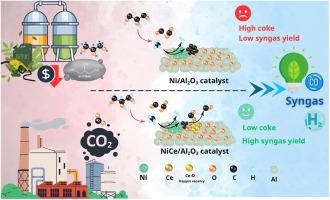Ce-promoted Ni/Al2O3 catalyst for enhanced sustainable syngas production from CO2 reforming of crude glycerol
IF 6.2
2区 工程技术
Q2 ENERGY & FUELS
引用次数: 0
Abstract
Dry reforming of glycerol (GDR) presents an alternative approach to syngas production by converting glycerol, a byproduct of biodiesel, with CO2. This study systematically investigated the effect of Cerium doping on Ni/Al2O3 catalyst synthesized via the wetness sonicated-assisted impregnation method. The effect of Ce promotion was studied at 0.5–3 wt%, conducted temperatures ranging from 650 to 750 °C and glycerol to CO2 ratios from 1:0 to 1:4 in a fixed-bed reactor. The results show that Ce doping enhances catalyst basicity and modifies surface morphology by enlarging the CeOx–nickel aluminate pore volume and reducing NiO crystallite size, thereby facilitating the formation of a synergistic NiO–NiAl2O4 active phase. Consequently, the improved adsorption of CO2 molecules enhances glycerol conversion and significantly increases CO yield. The results show that the H2/CO ratio in the syngas ranges from 0.8 to 1.2, with values below 2 being suitable for the Fischer-Tropsch reaction. Among the examined catalysts, the 1Ce10Ni/Al2O3 catalyst, benefiting from an improved glycerol conversion of ∼60 %, correlates with higher yields of H2 (53 %) and CO (73 %), showing a notable 1.5 times improvement in glycerol conversion and 1.3–1.6 times greater yields of hydrogen and CO compared to the catalyst unpromoted catalyst, at reaction temperature of 700 °C. This finding underscores the substantial influence of CeOx doping on catalytic performance, highlighting the critical role of optimizing the H2/CO ratio to achieve maximum glycerol conversion efficiency. Furthermore, the apparent glycerol activation energy decreases significantly from 60.21 kJ mol−1 to 35.99 kJ mol−1, demonstrating that Ce promotion contributes to the superior activity of 1Ce10Ni/Al2O3 compared to its unpromoted Ni/Al2O3. In general, the glycerol to CO2 ratio (GCR) were the dominant parameters influencing reaction products, with the optimized GCR found to be 1:1.

ce促进的Ni/Al2O3催化剂促进粗甘油CO2重整可持续合成气生产
干重整甘油(GDR)提出了一种替代合成气生产的方法,将甘油(生物柴油的副产品)与二氧化碳转化。本文系统地研究了铈掺杂对湿声辅助浸渍法制备Ni/Al2O3催化剂的影响。在固定床反应器中,在0.5-3 wt%、650 ~ 750℃、甘油与二氧化碳的比例为1:0 ~ 1:4的条件下,研究了Ce的促进效果。结果表明,Ce的掺杂通过增大ceo -铝酸镍的孔隙体积和减小NiO晶粒尺寸,提高了催化剂的碱性,改变了表面形貌,从而促进了NiO - nial2o4活性相的协同形成。因此,CO2分子吸附的改善提高了甘油转化率,显著提高了CO产率。结果表明,合成气中H2/CO比值在0.8 ~ 1.2之间,小于2的合成气适合进行费托反应。在所测试的催化剂中,1Ce10Ni/Al2O3催化剂在反应温度为700℃时,甘油转化率提高了~ 60%,H2(53%)和CO(73%)的产率提高了1.5倍,氢气和CO的产率提高了1.3-1.6倍。这一发现强调了CeOx掺杂对催化性能的实质性影响,突出了优化H2/CO比以实现最大甘油转化效率的关键作用。此外,甘油表观活化能从60.21 kJ mol−1显著降低到35.99 kJ mol−1,表明Ce的促进作用使1Ce10Ni/Al2O3的活性优于未促进的Ni/Al2O3。总的来说,影响反应产物的主要参数是甘油与二氧化碳的比(GCR),优化后的GCR为1:1。
本文章由计算机程序翻译,如有差异,请以英文原文为准。
求助全文
约1分钟内获得全文
求助全文
来源期刊

Journal of The Energy Institute
工程技术-能源与燃料
CiteScore
10.60
自引率
5.30%
发文量
166
审稿时长
16 days
期刊介绍:
The Journal of the Energy Institute provides peer reviewed coverage of original high quality research on energy, engineering and technology.The coverage is broad and the main areas of interest include:
Combustion engineering and associated technologies; process heating; power generation; engines and propulsion; emissions and environmental pollution control; clean coal technologies; carbon abatement technologies
Emissions and environmental pollution control; safety and hazards;
Clean coal technologies; carbon abatement technologies, including carbon capture and storage, CCS;
Petroleum engineering and fuel quality, including storage and transport
Alternative energy sources; biomass utilisation and biomass conversion technologies; energy from waste, incineration and recycling
Energy conversion, energy recovery and energy efficiency; space heating, fuel cells, heat pumps and cooling systems
Energy storage
The journal''s coverage reflects changes in energy technology that result from the transition to more efficient energy production and end use together with reduced carbon emission.
 求助内容:
求助内容: 应助结果提醒方式:
应助结果提醒方式:


